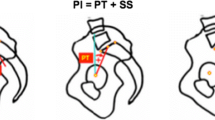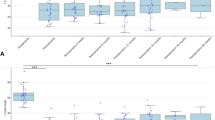Abstract
We postulated that the lowest instrumented vertebra (LIV) can be determined based on the apical vertebra. Seventy-two Lenke type 1 patients (average age: 13.6 years) receiving posterior spinal fusion were randomised into two groups. In group A, the apical vertebra was used to determine the LIV and in group B the neutral vertebra was used. All patients had Cobb angles <90° and average follow-up was over three years. Posteroanterior and lateral standing radiographs were used to assess flexibility, Cobb angle and distance from the C7 line to the central sacral vertical line. Both methods produced statistically significant changes in Cobb angle, sagittal T5–T12 and plumb line deviation, and there were no significant differences between the two methods. More cases of imbalance occurred in group B (five) than group A (two). We conclude that the apical vertebra can be used to determine the LIV in patients with Lenke type 1 adolescent idiopathic scoliosis.





Similar content being viewed by others
References
Behensky H, Giesinger K, Ogon M et al (2002) Multisurgeon assessment of coronal pattern classification systems for adolescent idiopathic scoliosis: reliability and error analysis. Spine 27:762–767
Bridwell KH, McAllister JW, Betz RR et al (1991) Coronal decompensation produced by Cotrel-Dubousset “derotation” maneuver for idiopathic right thoracic scoliosis. Spine 16:769–777
King HA, Moe JH, Bradford DS et al (1983) The selection of fusion levels in thoracic idiopathic scoliosis. J Bone Joint Surg Am 65:1302–1313
Knapp DR Jr, Price CT, Jones ET et al (1992) Choosing fusion levels in progressive thoracic idiopathic scoliosis. Spine 17:1159–1165
Lenke LG, Betz RR, Haher T et al (2001) Multisurgeon assessment of surgical decision-making in adolescent idiopathic scoliosis: curve classification, operative approach, and fusion levels. Spine 26:2347–2353
Lenke LG, Betz RR, Harms J et al (2001) Adolescent idiopathic scoliosis: a new classification to determine extent of spinal arthrodesis. J Bone Joint Surg Am 83-A:1169–1181
Liu Y, Li M, Zhu XD et al (2009) Retrospective analysis of anterior correction and fusion for adolescent idiopathic thoracolumbar/lumbar scoliosis: the relationship between preserving mobile segments and trunk balance. Int Orthop 33:191–196
Potter BK, Rosner MK, Lehman RA Jr et al (2005) Reliability of end, neutral, and stable vertebrae identification in adolescent idiopathic scoliosis. Spine 30:1658–1663
Puno RM, An KC, Puno RL, Jacob A, Chung SS (2003) Treatment recommendations for idiopathic scoliosis: an assessment of the Lenke classification. Spine 28(18):2102, discussion 2114-5
Richards BS, Birch JG, Herring JA et al (1989) Frontal plane and sagittal plane balance following Cotrel-Dubousset instrumentation for idiopathic scoliosis. Spine 14:733–737
Suk SI, Lee SM, Chung ER et al (2003) Determination of distal fusion level with segmental pedicle screw fixation in single thoracic idiopathic scoliosis. Spine 28:484–491
Thompson JP, Transfeldt EE, Bradford DS et al (1990) Decompensation after Cotrel-Dubousset instrumentation of idiopathic scoliosis. Spine 15:927–931
Conflicts of interest
None.
Author information
Authors and Affiliations
Corresponding author
Additional information
Fenghua Tao and Zhicai Shi contributed equally to this work.
Rights and permissions
About this article
Cite this article
Tao, F., Shi, Z., Xie, Y. et al. Determination of lowest instrumented vertebra by the location of apical vertebra in Lenke type 1 adolescent idiopathic scoliosis. International Orthopaedics (SICOT) 35, 561–567 (2011). https://doi.org/10.1007/s00264-010-1068-7
Received:
Revised:
Accepted:
Published:
Issue Date:
DOI: https://doi.org/10.1007/s00264-010-1068-7




